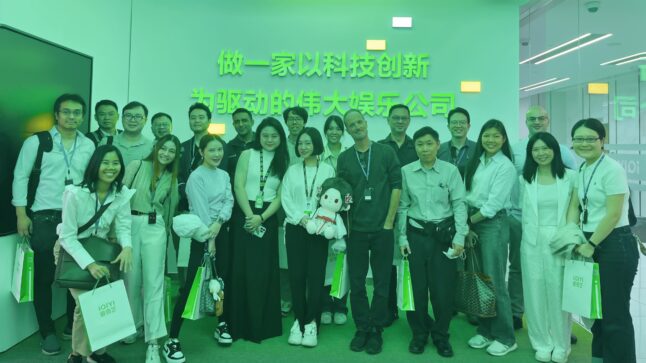We recently visited the iQIYI headquarters in Beijing. And this is my favorite company to follow in the “entertainment meets technology” space. They are the frontier of most of the interesting developments for how technology is changing long-form, high quality tv and movies.
I’ve written about iQIYI before.
- How they are integrating AI and now generative AI into the production of their serial dramas and feature films.
- How this plays out in multiple levels – such as production planning, production management, script analysis, marketing, and distribution.
- And how they are pushing the boundaries with virtual production, increasingly as a service for the industry.
You can learn more about this here.
- Why iQIYI Is the GenAI Innovator to Watch in Video Entertainment (Tech Strategy – Podcast 199)
- How iQIYI Is Using GenAI, Digital Assets and Virtual Production to Transform Video Entertainment (2 of 2) (Tech Strategy – Daily Article)
But you can put iQIYI’s “tech meets entertainment” strategy in two main buckets:
- Improving the user experience. Mostly viewers. But also, increasingly advertisers.
- Improving both the quality and efficiency of video production. For their own projects and increasingly at the industry level.
Their media relations team put out a slide with a great summary of this.
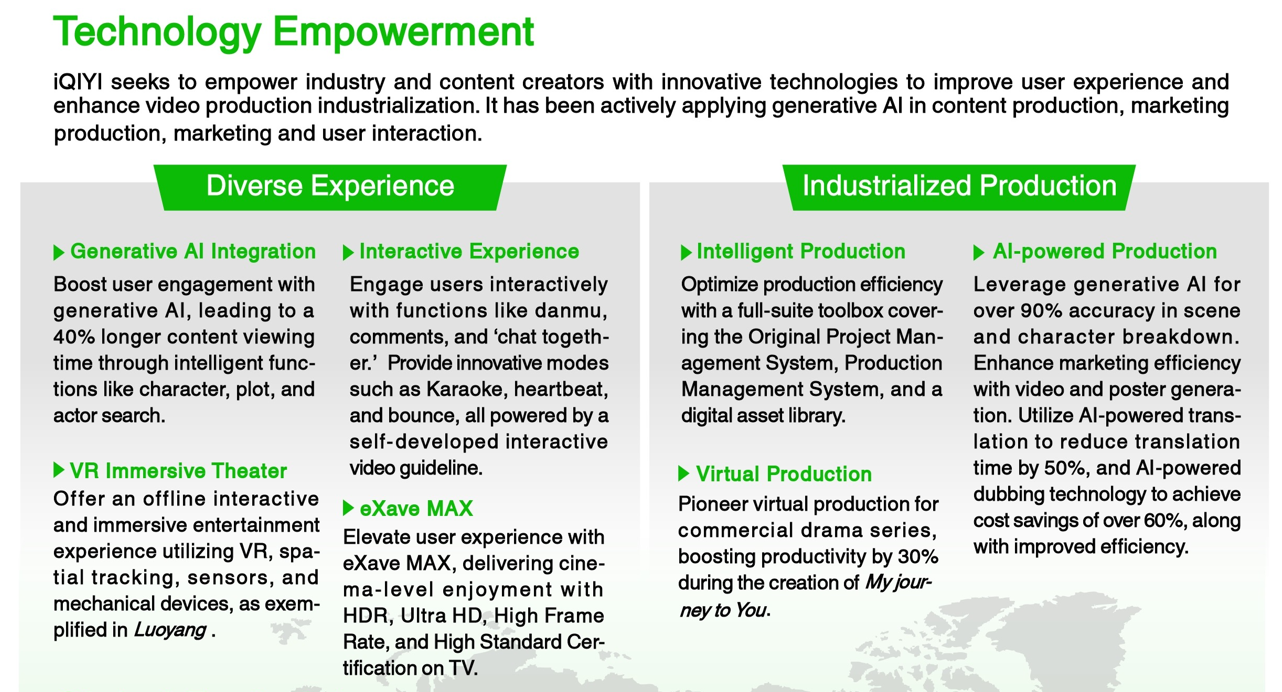
Strategy 1: Tech to Improve the User Experience
In the graphic, they list this as “diverse experience”. That’s kind of fuzzy. Really we are talking about adopting digital tools and features that keep driving the user experience forward. Constant, never-ending improvements. With personalization being the most powerful lever.
I have been talking about this forever in my Digital Operating Basics. It’s DOB2 (Never-Ending Personalization and Customer Improvements) and it is the key process in any digital and data-enabled business. I like when what companies are doing lines up with my frameworks.
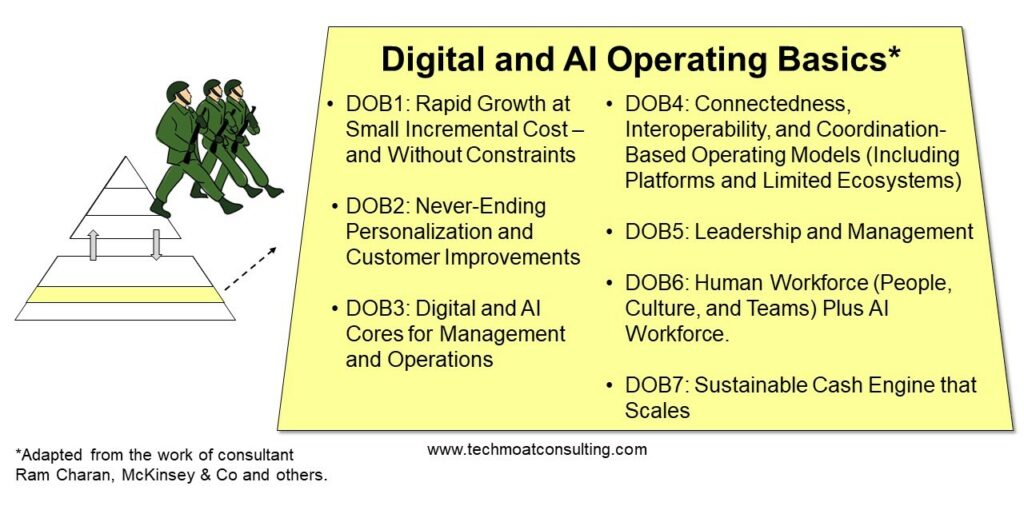
iQIYI breaks down their tech focus on the user experience into four buckets. From the graphic:
- Generative AI Integration. Basically, this is getting you to watch more videos by showing you the characters, plots, and actors you like. So, it’s data-driven personalization. They cite a 40% increase in user engagement.
- Interactive Experience. This is important. They are building functionality into their apps that increase interactions and engagement. So, lots of chat, comments, joint singing, etc. This gets you a far more powerful customer relationship than just passive viewing. It can create communities. It gets you far better retention. And it generates lots of data that makes you smarter and more effective at DOB2.
- VR Immersive Theater. This mostly about expanding beyond just video screens (tv, smartphone, iPad). They have been expanding into dimensions like VR and spatial tracking. They are even building VR theatres around town.
- eXave MAX. Ok, this is about making higher and high-quality screens (Ultra HD, etc.). It’s about exceptional audio and video experiences. As devices get better and better, you need video created at higher and higher levels of quality. You can’t watch iPhone shot TikTok videos on 100-inch ultra-HD televisions.
Overall, that is a really solid plan for leveraging technology to improve the user experience. And, as mentioned, this includes both viewers and advertisers.
These are the main apps by which they interact with viewers.
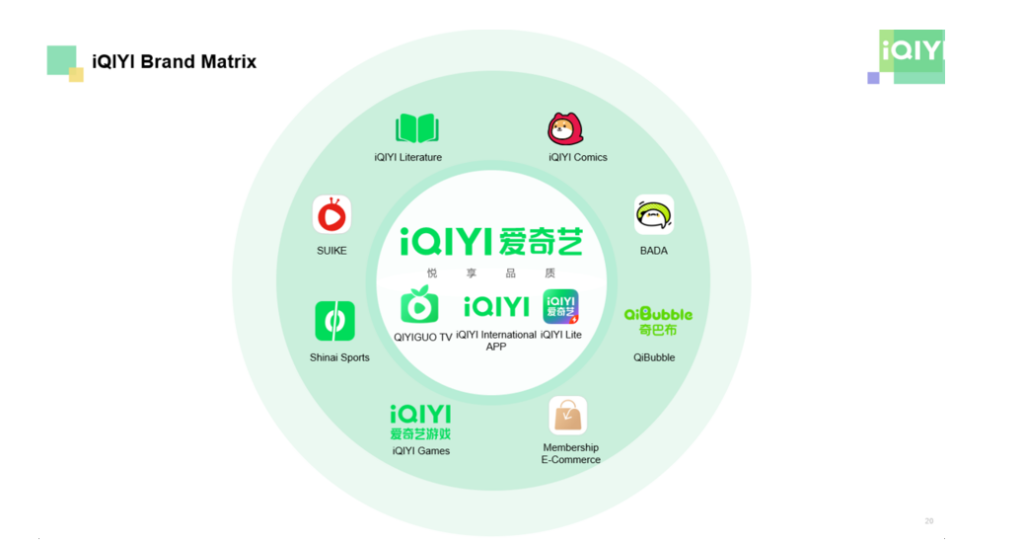
Note: iQIYI had an interesting recent announcement where they cited a 6% jump in advertising revenue year-over-year (US$205.3 million). And generative AI was driving an interesting increase in performance marketing, which is unusual. Typically, movies and tv shows are mostly about brand marketing. But performance ad revenue hit historical high due to the use of Gen-AI, and performance ad revenue reached 40% of total ad revenue (according to 24Q1 earnings call QA session).
For all the big talk about strategy, getting better data and using AI can really result in jumps in advertising matching and effectiveness. This is turning out to be the most common use case for new AI tools. Just better advertising and marketing.
Strategy 2: Tech to Industrialize and Virtualize Production
The other big “tech drives entertainment” bucket is “industrialized production”. How do you move beyond lots of crews doing productions over months using sets and cameras? How do you move beyond various production companies and teams to more of an industrial solution? Think a big entertainment factory instead of lots of workshops.
And the key distinction here is that iQIYI does high-quality video entertainment. They are not doing short videos. They are creating the highest quality TV and film entertainment. This is advanced story telling (running for seasons), with the highest production value.
And it’s not just high quality. They are also creating hit shows that are topical. That are cultural phenomena. They are riding and creating entertainment and cultural trends. This is the highest level of entertainment. And it’s very difficult. Only a few companies can do this (HBO, Disney, etc.).
iQIYI has a great track record at this.
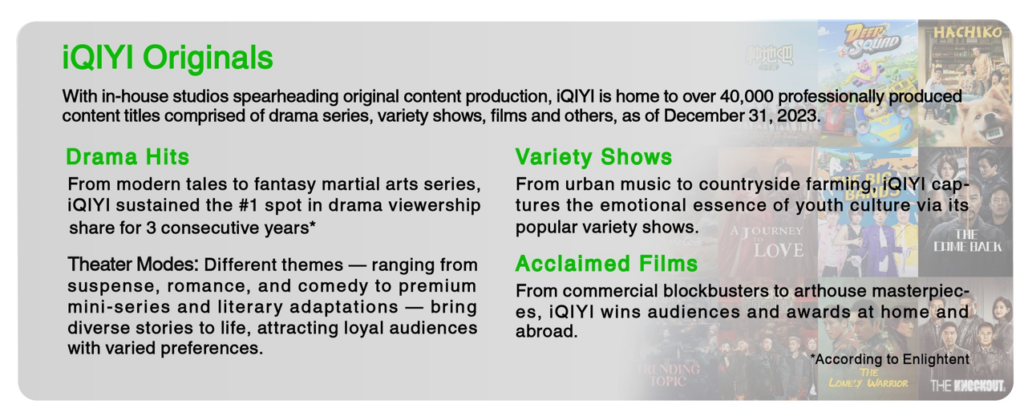
Take a look at the two strategy buckets again. Look at the section on the right.

“Industrialized Production” is an interesting phrase. They do appear to be going for a factory and industrial model for their type of entertainment. And that is a sea change the workshop approach (with lots of small production companies making films).
You can see the basics for data-driven production (“Intelligent Production”). Lots of tools for production management, asset libraries, etc.). These are the tools they have been building out for a long time. Lots of efficiencies. Lots of data insights. Think standard data analysis and software.
The more interesting section is the “AI-Powered Production”. This is when you start to integrate all the emerging generative AI tools into things like script analysis, dialogue improvements, better marketing materials, and better poster generation. This is generating content that is part of the production. Plus, you can do things like reduced translation time and costs.
The difference in this bucket is it’s not just doing things faster and cheaper. This is about doing things better than before. It’ is about making better content, posters, scripts, characters, dialogue, etc. And it does this by providing a wide range of creative tools to staff that would not normally have them. Suddenly everyone can generate scripts in minutes. Everyone can draw new unique characters in minutes. Everyone can generate funny dialogue. This is the democratization of the creative process. That’s fantastic for all of us. But bad if you spent 5 years going to art school.
And the most exciting bucket is “Virtual Production”. This is the real frontier.
This is when they begin to offer industrial-scale services that anyone can use to create TV shows and films. This is similar to how gaming engines enable all sort of game developers to make really advanced games. Using virtual production capabilities, any content creator can upload shot film, sounds, music, graphics, scripts, voices, characters and so on. And they can they create their production virtually (in the game engine).
iQIYI is going to combine with unique virtual production capabilities their access to their growing IP library, legions of contract workers on stand-by and lots of available digital assets and services. It’s a really powerful strategy.
This is the iQIYI graphic I keep pointing to as the future of tech-empowered video entertainment.

It’s worth looking at the components.
- The right blue circle is the virtual production services. It’s the suite of tools that content creators (in-house and external) can use to complete and generate their films.
- The inputs are below in green. You bring in talent as needed (think Upwork for production staff). You bring in media and other digital assets you have created, purchased, or licensed.
- And the whole thing has lots of intelligence to predict performance. That’s the blue circle on the left.
This graphic needs work but it has the main pieces.
***
High Quality Video Entertainment Is a Really Difficult Business
If you look at the iQIYI financials, you can see the business is basically run on subscriptions and advertising. And then distribution and IP monetization are growing sources of revenue.
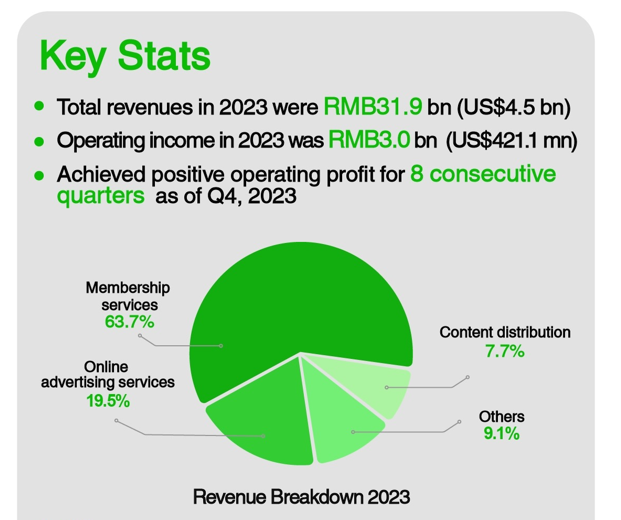
And it’s important to note how much the entire iQIYI revenue model depends on premium quality entertainment. And on creating and rising entertainment and cultural trends.
- People subscribe because they want to see the new hit show.
- Advertising disproportionally wants to go to the top drama series. The shows that everyone is talking about.
So iQIYI is really dependent on staying on the top in terms of entertainment quality. And on the cutting edge of culture, society, and entertainment. It’s a tough business. Creating hit shows consistently is difficult. But iQIYI has been doing it consistently for +10 years.
This is also important for IP monetization. Which is something we talked a lot about during our visit.
Why China is the Exciting Frontier for IP Monetization
iQIYI is generating a lot of owned IP from its various production houses. This IP covers dramas, animation, artists, variety shows, virtual idols and other content. Here’s how they describe it.

And they can then build on this IP by:
- Expanding and re-creating the content. They can use the characters, props, scenes, and images. They can basically create more content.
- Creating physical products. This can be done internally or, more likely, with partnerships. They can work with razor and toy companies to create versions of their characters. They can create new types of bubble tea for their hit movies. They can have pop-up shops.
- Repurposing to other digital environments. Hit tv shows can become video games, VR, live events, and ecommerce.
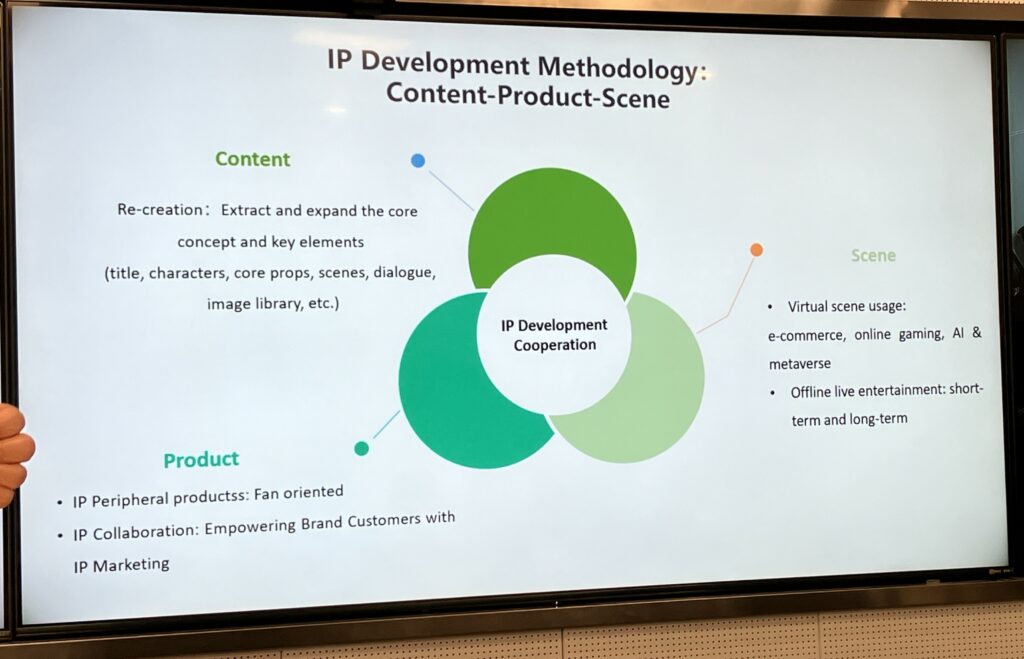
Here’s an example for their super popular TV show Mysterious Lotus Casebook.
They’ve taken their hit show, its characters, its vehicles, its sets and everything else and turned them into jewelry, models, toys, lamps, bubble tea, and even pet food (the show has famous animals in it).

We can see a similar business cases for IP monetization for popular tv shows in the US and Japan. Nothing too surprising. Game of Thrones was a hit. People signed up. And products started hitting the shelves. Everything from spin-off books to backpacks.
What makes IP monetization in China the exciting frontier is:
- Its massive digital consumer base.
- Its massive domestic manufacturing base
A hit tv show that debuts on Thursday in China can ripple through the ecosystem. Chinese consumers digitally switched on and popular trends take off within days. And there are lots of them. Chinese consumers are closely tied to their smartphones and to each other. Trends happen much faster and much bigger.
The hit tv show can have entirely new products launched and available in weeks. This depends on the type of show but the Chinese manufacturing ecosystem is right down the street. If one particular character or set piece is particularly popular, they can design and distribute new products for it rapidly.
Ecommerce companies and manufacturers are closely linked to the digital ecosystem. And to the smartphones of consumers. When they see popular trends, they can design and distribute entirely new products in days.
No other country in the world can operate this fast in terms connected consumers and manufacturers.
That is important if you are in the business of creating high quality entertainment that is trend setting and aiming for cultural impact. iQIYI’s IP monetization is going to much more powerful. But it also happens at a faster pace, which is a challenge. Trends and waves are going to hit faster. And you can jump on and ride them very quickly. But new waves will also emerge frequently. It’s an exciting but frantic game.
I did ask the iQIYI staff whether it was getting easier or harder to create and ride the entertainment waves in China. They basically said it was getting easier. The data is getting better and better and its less guessing than it used to be.
Here’s a good summary of what they are doing in IP monetization.

I think it’s only a matter of time before Hollywood studios start piggybacking the China system. The same way US retailers are now benefiting by linking to the fast responsiveness of Chinese manufacturers. Cross-border companies like Shein and Temu have been leveraging their close ties to Chinese manufacturing to beat US retailers on speed and flexibility.
***
Anyways, it was a great visit. Except for me having pneumonia. Otherwise really awesome.
Thanks and cheers, Jeff
——–
Related articles:
- AutoGPT and Other Tech I Am Super Excited About (Tech Strategy – Podcast 162)
- AutoGPT: The Rise of Digital Agents and Non-Human Platforms & Business Models (Tech Strategy – Podcast 163)
- Why ChatGPT and Generative AI Are a Mortal Threat to Disney, Netflix and Most Hollywood Studios (Tech Strategy – Podcast 150)
From the Concept Library, concepts for this article are:
- Video
From the Company Library, companies for this article are:
- iQIYI
——–
I am a consultant and keynote speaker on how to supercharge digital growth and build digital moats.
I am a partner at TechMoat Consulting, a consulting firm specialized in how to increase growth with improved customer experiences (CX), personalization and other types of customer value. Get in touch here.
I am also author of the Moats and Marathons book series, a framework for building and measuring competitive advantages in digital businesses.
This content (articles, podcasts, website info) is not investment, legal or tax advice. The information and opinions from me and any guests may be incorrect. The numbers and information may be wrong. The views expressed may no longer be relevant or accurate. This is not investment advice. Investing is risky. Do your own research.
